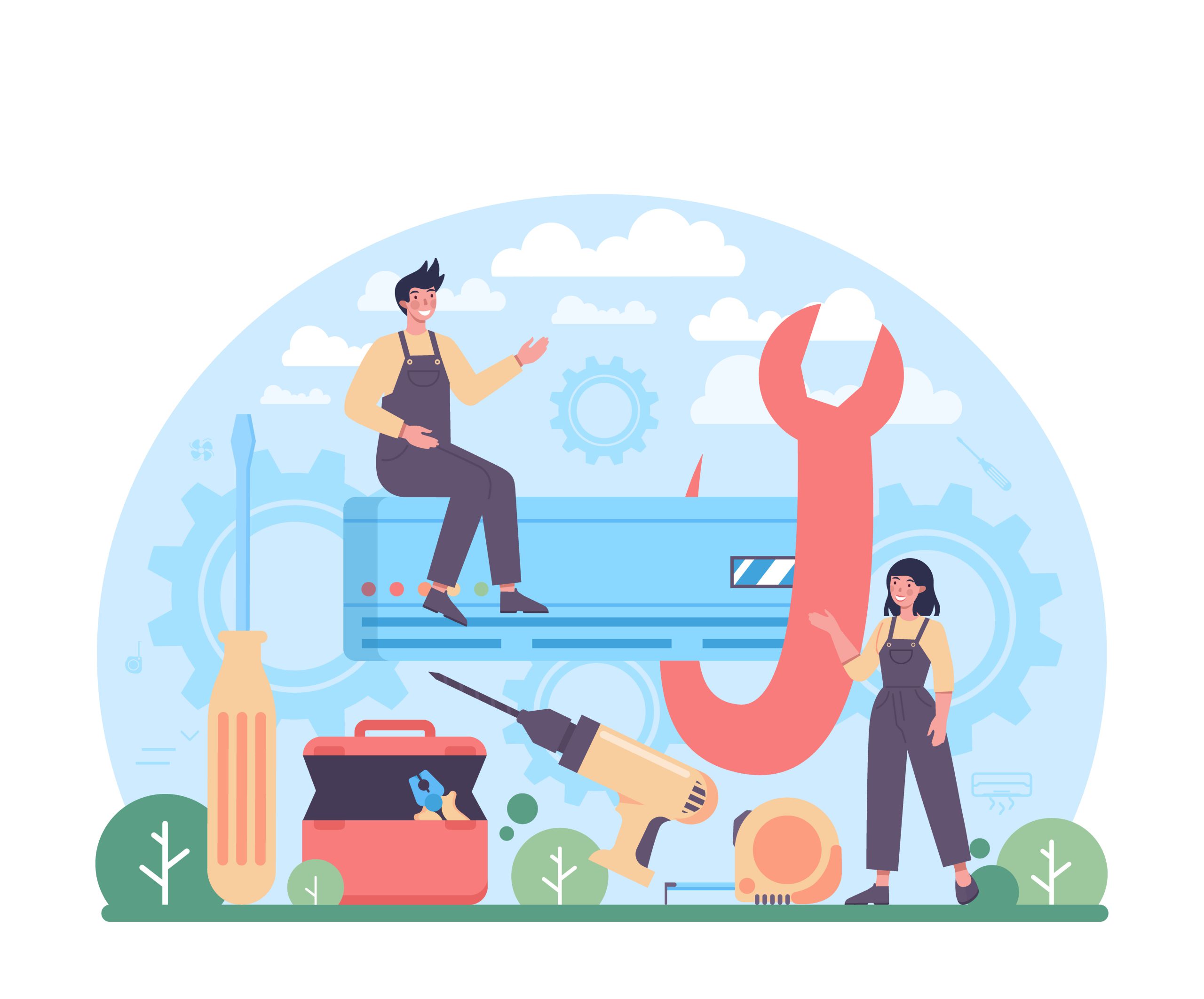
Your comprehensive guide to all types of maintenance
Maintenance has many important steps that certainly differ from one piece of equipment to another. All types of equipment come together in the different types of maintenance that must be performed, regardless of their type or purpose.
Periodic maintenance (Time based maintenance) – TBM
Periodic maintenance is one of types of maintenance that includes cleaning, checking, and periodic inspection of the equipment. And replacing some parts and components before they are damaged, to prevent sudden failure of the equipment, and thus disrupt the production process. Therefore, the periodic period of change depends on the usual or expected life span of this part. This maintenance is planned in advance without stopping the equipment from working, according to the recommendations of the producing company, and according to the maintenance schedule set for that. Regular maintenance reduces breakdowns as a result of replacing parts and parts before damage occurs. The periodic maintenance intervals depend on what is mentioned in the equipment operation and maintenance manual, i.e. the manufacturer’s recommendations, as well as the experience of the workers and the history of the maintenance of the equipment.
Predictive Maintenance (Condition-based maintenance- CBM)
One of the types of maintenance includes all maintenance work that is done to preserve the important parts of the equipment until the end of its useful life, through periodic monitoring of some basic operational elements, to notice any change that may cause a decrease in performance efficiency, before it reaches a state of failure. full. This type of maintenance attempts to discover faults by predicting the condition of the internal equipment, examining the temperature at some points on the equipment by touching it by hand, as well as measuring vibrations on certain points of the equipment, or noticing some abnormal sounds, and based on the results of examination, diagnosis, and analysis In the data, failure trends are evident.
Autonomous maintenance – JISHU HOZEN
Implemented as part of a TPM program, self-maintenance is the cornerstone of a TPM system. The self-maintenance stems from the idea that the operator on the equipment is the one who must maintain it, as he himself performs all or some of the routine maintenance of the equipment, so he knows its smallest details and maintains it as if it were his property.
The application of self-maintenance is preceded by training and qualifying operators to be able to carry out some basic maintenance tasks for their equipment, to maintain it, not to deteriorate its condition, and to focus on keeping it within good operating conditions. This requires training them to perform daily routine maintenance and to know some simple repair work. And the workers are in a position where they are able to locate the defects and repair them, without having to stop the work for a long time waiting for the repair work to be carried out by the specialized technicians. As well as creating improvements to the components of the manufacturing process.
Self-maintenance includes cleaning, lubrication, inspection and inspection, and some simple maintenance activities that do not need to call the maintenance crew to perform so the maintenance team devotes itself to doing more complex maintenance work that requires high professionalism. Therefore, the efficiency of self-maintenance depends on the level of training and capabilities of the workers who operate the equipment, and the degree of cooperation between the various departments and departments, especially operation and maintenance.
Self-maintenance contributes to achieving zero breakdowns and has an indirect role in achieving zero losses, zero defects, and zero work accidents.
It often begins with essential work such as lubrication, cleaning, examination, and inspection, and progresses to minor and possibly major repairs.
Small repairs may include the following tasks
- Tighten loose bolts and nuts.
- Replace worn parts.
- It is the tightening of couplings and nuts.
- Carry out accurate checks.
- Adjust sensors or sensors.
According to the Institute of Project Maintenance in Japan JIPM, the main skills that must be available in the operator in self-maintenance include the following
- The ability to detect abnormal (abnormal) events in the operation of the equipment or its components.
- The possibility of dealing with the stomach and restoring the stomach to its functions.
- The ability to adjust the equipment in its optimal operating conditions.
- The ability to maintain and keep the equipment under optimal operating conditions.
There are four operator skill levels for self-maintenance
- The ability to identify any abnormal event in the operation of the equipment or its components and the ability to diagnose the causes of malfunctions.
- The possibility of identifying the components of the equipment and its functions, so that it can operate it without problems.
- The ability to understand the relationship between equipment and quality, that is, to identify the causes of quality defects resulting from the equipment.
- Make repairs to the stomach.
- The ability to disassemble and install spare parts.
- Predict the life of the spare part.
- The ability to identify the causes of failure.
Positive effects of self-maintenance
- The condition of the equipment is known at all times.
- Reduced breakdowns to a minimum.
- Preventing corrosion or rusting of equipment components, delaying wear and tear, and extending the life of the equipment.
- Reducing spare parts costs.
- Improving the operation ratio of the equipment.
- Improve the capacity and efficiency of the equipment.
Corrective Maintenance – 1957
It is defined as the maintenance work that must be carried out in the event of a breakage. it defects or malfunctions in a part or parts of the equipment. With the aim of restoring its operational efficiency, it includes the following:
- The work of repairing or replacing some parts or components to restore the equipment or machine to its normal state after it has reached a state of breakdown or failure to perform its functions.
- Maintenance workers are carried out through the periodic monitoring of some of the basic operational elements to notice any change that may cause failure or a decrease in efficiency before it reaches a state of failure.
- Performing repair operations on some parts, with the aim of reusing them again, such as repairing a partially corroded or cracked part.
- Replacement of damaged or outdated components.
- Perform adjustments and calibrations for some parts of the machine that need this.
Maintenance Prevention – 1960
Comprehensive productive maintenance is concerned with developing new designs for equipment, based on eliminating the need for maintenance. At least facilitating access to parts of the equipment so that maintenance operations can be carried out with ease. By operating the equipment and performing planned maintenance, more knowledge is gained about the equipment and its components. This knowledge can be used to continuously improve maintenance plans and improve productivity.
All data collected about the equipment during operation and maintenance operations are studied. If defects in the current equipment are identified, help make modifications to it. Or when designing new equipment. So as to prevent sudden stops and breakdowns, achieve ease in maintenance work and manufacturing operations, prevent defects in products, and achieve security and safety for workers.
And since the company incurs large expenses on maintenance work, the work of new designs for the equipment is able to reduce the volume of maintenance and the time spent on it. It will contribute to a large extent in reducing maintenance expenses, and thus increase the overall profitability of the company.
Emergency Maintenance
Carrying out the necessary and serious maintenance work for breakdowns and damages. A repair is a group of operations that are carried out to repair machines as a result of a sudden breakdown. The reason for this may be a failure to implement the correct preventive or periodic maintenance. This breakdown causes the machine to stop working until the end of the repair.
Shutdown maintenance
Maintenance work is carried out only when the equipment is completely off.
Running Maintenance
Type of maintenance work carried out on the equipment during work.
Repair Maintenance
Complete maintenance work aimed at repairing equipment after it has suffered malfunctions. To return it to its normal operational state, with acceptable specifications.
Overhaul/ recondition maintenance
Complete maintenance work to select and restore the equipment or a large part of it and restore it to its operational condition with acceptable specifications.
Service
Carrying out some operations aimed at repairing parts of the equipment to return it to its operational state.
Preventive maintenance
You can find here all about preventive maintenance and its importance.
Indicator of the efficiency of performing types of maintenance
Commitment to the efficient implementation of the annual maintenance plan is a good indicator of maintenance performance. Just as production has the plan to be fulfilled, maintenance also has the plan to be implemented.
The lower the ratio of emergency maintenance work to programmed maintenance work, this indicates the efficiency of maintenance performance.
Maintenance costs are an integral part of production costs and are included as an element affecting the price of the final product. The lower these expenses, the more efficient the performance. The role of maintenance is evident in reducing production costs through:
- Reducing the periods of periodic maintenance of production units. Thus adding the available time to the operating time, and thus increasing production.
- Determine high-maintenance devices and equipment to be replaced with newer and more efficient ones.
- Reducing accidents and breakdowns, thus reducing the costs of indirect losses.
- Also, good maintenance works to remove defects from the equipment so that defect-free products can be produced. Thus reducing the time spent on re-work, and waste in scrap.
The Overall Equipment Effectiveness (OEE) measure is used to determine the efficiency of types of maintenance performance. It is a phased measure to measure the success of the overall production maintenance program, by linking the six big losses to the following three measurements: Availability (Time), Performance (Speed) & Yield (Quality).
Importance and objectives of types of maintenance
Maintenance is a continuous process even if the machine or equipment stops working. Due to the factors that affect this equipment and machines, such as corrosion and rust, during their operational life. The importance of maintenance appears when the desired goals are achieved. These goals include:
- Permanent maintenance of the good condition of machinery or equipment and ensuring good performance and thus the quality and increase of production.
- Increasing the life of the machines and thus obtaining a large economic return.
- Reducing the occurrence of breakdowns and the economic losses they cause as a result of stopping the production process and restarting costs.
- Achieving stable operating conditions and thus increasing industrial safety conditions and climate for work sites.
- Determine the costs of repair and include them in the general budget of the system.
There are also many of these goals that are determined according to the needs of different work sites.

























